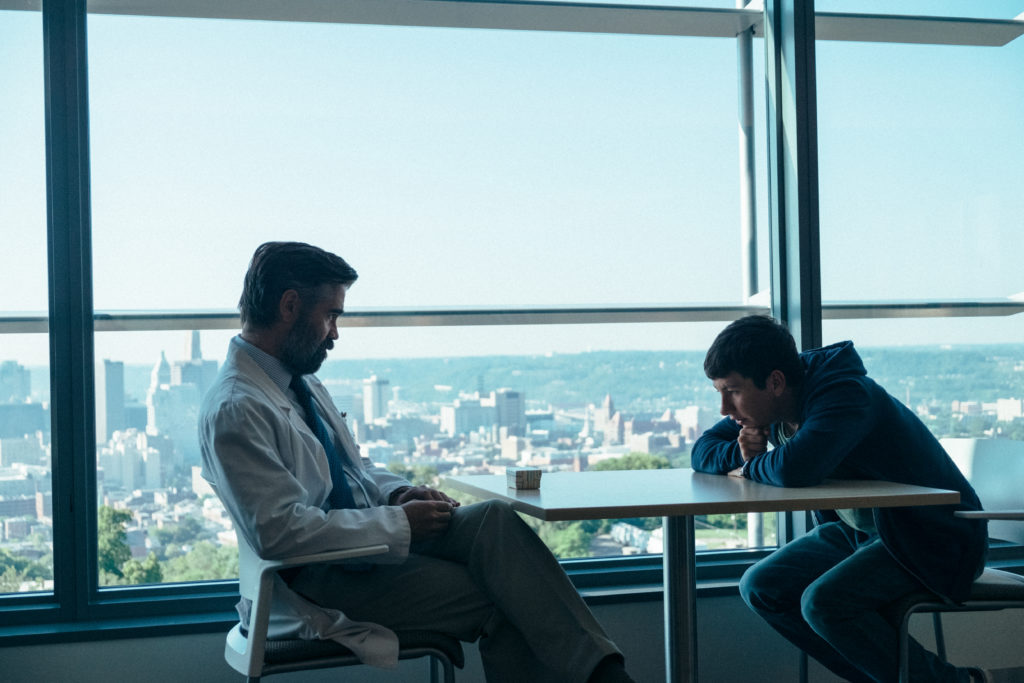The scariest film of the year isn’t about killer clowns or possessed dolls or a baby-faced murderer. It’s a film about a man with the perfect life. A man whose past comes back to torment him. Greek director Yorgos Lanthimos (“Dogtooth,” “The Lobster”) has one of the most instantly recognizable styles of any modern auteur — symmetrical framing, the deadest of deadpan dialogue and a disturbing look at social constructs — so it was only a matter of time before he tried his hand at a horror film. Thankfully, he did with “The Killing of a Sacred Deer,” which is easily his best and most unsettling film to date, as well as the year’s most viscerally shocking experience to be had at the cinema.
Steven Murphy (Colin Farrell) is a successful heart surgeon with a tidy suburban life. He lives in a massive house with his ophthalmologist wife Anna Murphy (Nicole Kidman) and his two children, Kim (Raffey Cassidy) and Bob (Sunny Suljic). Their family life is harmonious, with the only source of conflict being Bob’s refusal to cut his hair. But that harmony is disrupted by Martin (Barry Keoghan), a teenager who has an unusual friendship with Steven. Martin’s father died for unknown reasons on Steven’s operating table years ago. After Martin comes to the Murphys’ home for dinner, he infiltrates their carefully ordered life over time, becoming a friend to Bob and love interest to Kim. Martin then attempts to set Steven up with his mother (played by Alicia Silverstone in a return to big screen roles), and Steven’s rejection angers him.
One day, Bob wakes up and cannot move. Steven and Kim take him to the hospital, where they find nothing wrong and send him home. The parents brush it off as a lie to skip school, but then Bob collapses again, paralyzed, and starts deteriorating quickly. As his parents and medical staff struggle to understand why this is occurring, hiding their panic at being unable to find a logical cause, Martin offers Steven a clear answer. One by one, Steven’s wife and children will suffer. First, they will lose the ability to walk. Second, they will refuse all food. Third, they will bleed from the eyes. Last, they will die. Steven only has one way to stop it: choose to kill one of them in retribution for Martin’s father’s death, with limited time to spare before they all perish.
Permeating the entire film is the aesthetic of the hospital — a cold, antiseptic environment robbed of human emotion. It’s a natural fit for Lanthimos’ unmistakable style, along with a contrast to cinematographer Thimios Bakatakis’ beautifully grainy 35mm images. There’s even a strangely clinical touch to Steven and Anna’s favorite erotic game, in which she pretends to be under anesthesia while they have sex.
Lanthimos also adopts a distinctly Kubrickian flair here with his menacing tracking shots, slow zooms and cacophonous bursts of classical music. His approach would not work nearly as well without the tremendous work of the cast who are perfectly attuned to his idiosyncratic wavelength. Farrell and Kidman have rarely been better, while newcomer Keogan (spotted earlier this year in “Dunkirk”) is terrifying as the mysteriously villainous Martin.
All of those aesthetic decisions only make the viewer feel more uncomfortable as the film slowly builds, with the main narrative only shifting into gear nearly halfway through its runtime. The tension becomes unbearable while Steven faces his impossible decision — Lanthimos loves a uniquely absurd “what would you do” dilemma in his sociological observations. He twists a knife in the viewer’s gut, making some, like myself, feel physically ill as the high stress builds to a climax of explosive violence and release. Even if there are times when the ambitious package doesn’t entirely come together in balancing the narrative and thematic weights, it’s an unforgettable experience on a psychological level that horror films simply do not offer anymore.
“The Killing of a Sacred Deer” is also Lanthimos’ first film set in the United States, and fittingly tackles the subject of American suburban life. His style of stilted dialogue and the emotionless, medical tone brilliantly skewer the cookie-cutter lives of the suburban elite. Adding even more class commentary, like layers on a deliciously bitter cake, Martin and his mother live in an older, ramshackle home away from the surburbs. Lanthimos also clearly explores some Biblical notions of the battle between God and devil figures, the supernatural versus the scientific and the moral implications of a cycle of vengeance. However, the most potent allusion is to the Greek myth Iphigenia, on which Kim composes an essay in the film.
In the myth, Agamemnon is asked to sacrifice his daughter by the goddess Artemis. In several of ways, the film itself is, structurally and intertextually, a Greek tragedy with injections of pitch-black humor — all of these rich elements making it one of the most thoughtful, complex genre films in recent memory.
Grade: A-







